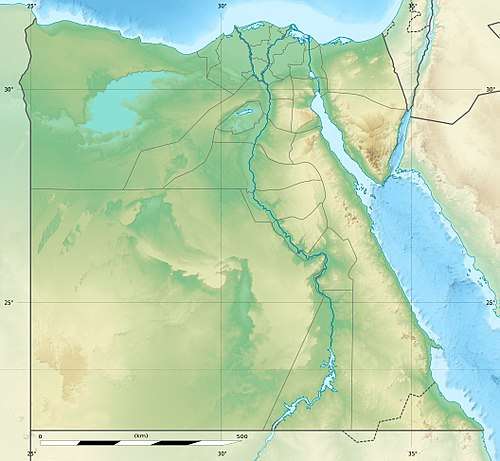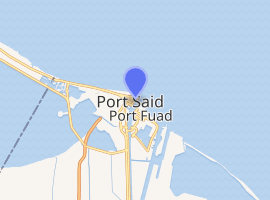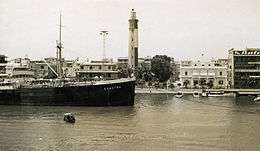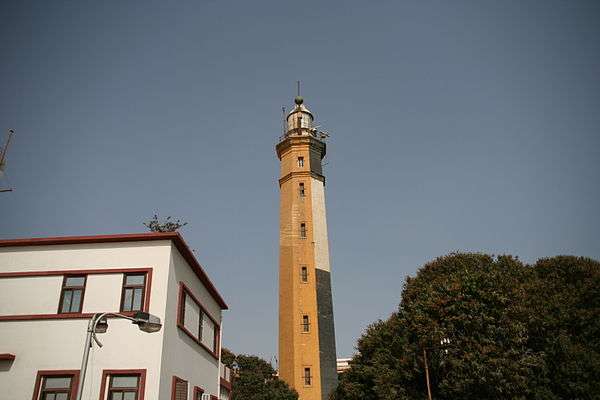Port Said Lighthouse
The Port Said Lighthouse is one of the most important architectural and tourist landmarks in the city of Port Said in Egypt. Considered a unique example for the evolution of architecture during the nineteenth century in the city, the lighthouse was designed by François Coignet at the request of the Khedive of Egypt and Sudan, Ismail the Magnificent. Construction was completed in 1869, one week prior to the inauguration of the Suez Canal. The lighthouse was built to guide ships passing through the canal. The lighthouse has an octagonal shaped tower that is 56 m high.
The lighthouse in 2008 | |
 Port Said Lighthouse | |

| |
| Location | East district, Port Said, Egypt |
|---|---|
| Coordinates | 31°15′50″N 32°18′42″E |
| Year first constructed | c. 1869 |
| Year first lit | 1869 |
| Deactivated | 1997 (?) |
| Foundation | Reinforced concrete |
| Construction | Masonry |
| Tower shape | Octagonal prism tower with balcony and lantern |
| Markings / pattern | unpainted tower except the seaward side painted white and black |
| Tower height | 56 m (184 ft) |
| Focal height | 59 m (194 ft) |
| Range | 40 km (25 mi) |
| Admiralty number | N5978 |
| ARLHS number | EGY-016[1] |
History

From 1868 until the end of his reign, Khedive Ismail ordered the construction of lighthouses at different points across Egypt's Mediterranean coast.[2] Among these, the lighthouse of Port Said had special significance owing to its connection to the Suez Canal, the national infrastructure project undertaken during Ismail's reign. Ismail commissioned French architect François Coignet to design the lighthouse, and oversee its construction. Coignet used the novel technique of building the lighthouse out of reinforced concrete. The lack of nearby stone quarries and the cost of importing stone from elsewhere caused those in charge of construction to become interested in the use of concrete.
At the time, the lighthouse was a paragon of modernism worthy of an international reputation. The lighthouse was constructed by layering liquid 20 – 25 cm in thickness. To ensure the structural cohesion of the whole, iron wall ties were inserted. The use of concrete was doubly innovative: employed as a distinct material, not merely a substance for filling, and strengthened with metal rods. Quite simply, reinforced concrete had been invented.[3][4][5] The use of electric light (powering an arc lamp) made it possible to display a consistent flashing light and it was a state of the art lighthouse at the time.
Nothing of the original Port Said remains except for the lighthouse, which has been pushed to the interior of the city by the gradual silting of the port, and, therefore, no longer of use for its original purposes of guiding ships. In 2010, intellectuals called for it to be turned into a museum of maritime transport. In January 2011, the Port Said lighthouse was officially registered as a national monument in Egypt.
References
- Rowlett, Russ. "Lighthouses of Egypt". The Lighthouse Directory. University of North Carolina at Chapel Hill. Retrieved 20 November 2015.
- "Archived copy". Archived from the original on 2 April 2011. Retrieved 7 February 2011.CS1 maint: archived copy as title (link)
- Port-Saïd : architectures XIXe-XXe siècles. IFAO. 2005. Retrieved 20 October 2016.
- Frost, G.H. (27 June 1885). Engineering News and American Contract Journal, Volumen 13. University of Iowa. p. 406. Retrieved 20 October 2016.
- Port-Saïd : Architectures XIXe-XXe siècles Broché – 21 avril 2011
External links
| Wikimedia Commons has media related to Port Said Lighthouse. |
